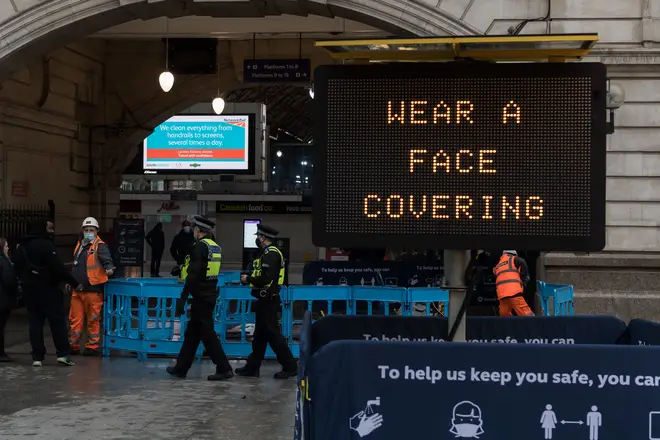
Vanessa Feltz 3pm - 6pm
23 December 2020, 20:26

Official guidance reveals rapid rises in week-on-week Covid-19 case rates are behind the decision to move some areas into Tier 4, with some places seeing rates more than double.
Some six million people in England will be living in Tier 4 following new rules announced at Wednesday's briefing by Health Secretary Matt Hancock.
Guidance from the Department of Health has outlined some of the reasoning behind the decisions in local areas, largely focusing on case rates, following exponential rises.
Read more: Which new areas will enter Tier 4 and what are the new Christmas rules?
The impact on the NHS has also been considered following increased hospital admissions in some areas.
West Sussex and the parts of East Sussex currently in Tier 2, including Brighton and Hove, will move up into Tier 4 after conditions in the area "deteriorated considerably", the Department of Health said.

Matt Hancock announces further Tier 4 restrictions across England
The guidance stated that case rates in all ages were increasing in almost all areas, with eight out of the 11 local authorities not currently under Tier 4 restrictions seeing case rates increasing above 100% in the past week.
The number of daily Covid-19 hospital admissions in the local NHS continued to increase and now "significantly exceeds" the peak seen in the first wave of the virus.
The Department of Health added that while the proportion of critical care beds occupied by Covid-19 patients was increasing, it was still lower than the previous peak.
Hampshire, including Southampton, will also move from Tier 2 up to Tier 4 from Boxing Day.
Case rates in all ages were rapidly increasing in most local authorities, the Department of Health said, with Rushmoor a particular concern.
Rushmoor, which borders areas previously placed in Tier 4, has an overall case rate of more than 300 per 100,000, which has increased by 134% in the past seven days.
⚠️ A number of areas will move into higher tiers from 00:01 on Saturday 26 December.
— Department of Health and Social Care (@DHSCgovuk) December 23, 2020
The government has decided to act ahead of the formal review point, in order to contain the spread of the new strain of #COVID19.
See the list of local restriction tiers by area 👇
Daily Covid-19 hospital admissions to the local NHS were also increasing, with rising numbers of patients in critical care. Bed occupancy was below the national average but was rising.
In Oxfordshire, which will move from Tier 2 to Tier 4, case rates have risen 89% to 202 per 100,000 in the past week.
The Department of Health said there were particular concerns over the case rates of people aged over 60 in Oxford, which were up over 100% to 212 per 100,000 per week.
Hospital admissions with Covid-19 were rising in the Buckinghamshire, Oxfordshire and Berkshire West NHS, with occupancy at the national average but also increasing.
The parts of Essex still in Tier 2 will move into Tier 4 on Boxing Day.
The Department of Health said the situation in Colchester, Tendring and Uttlesford was "quickly deteriorating" as case rates were now above 200 per 100,000 per week.

Hancock: New Covid strain discovered in UK
Covid-19 hospital admissions in the local NHS in these parts of Essex were continuing to rise steeply, as was critical care occupancy.
In Waverley, the only part of Surrey not yet in Tier 4, case numbers were rising "exponentially" recent data suggested, according to the Government guidance.
The current Tier 2 area saw a significant increase in case rates in the past week of 139%, leading to a rate of 214 per 100,000.
There are also concerns over hospital admissions data, which together had warranted an increase to Tier 4, the Department of Health said.
All of Cambridgeshire will move from Tier 2 to Tier 4 after case rates increased by 50% or more in all local authorities in the region and Peterborough.
Huntingdonshire saw a 165% increase and South Cambridgeshire reported a 133% increase in case rates in the last week.
The district of Fenland was of particular concern, the Department of Health said, after the case rate in people aged over 60 increased to 154 per 100,000 per week.
Case rates in Norfolk had increased by at least 30% in the last week, with Breckland reporting an increase of 106% in cases since last week.
The case rate of those aged 60 or older in Breckland now stands at 138 per 100,000 per week.
Daily Covid-19 bed occupancy had risen to the national acute hospital average in the Norfolk NHS and continued to rise, but critical levels were stable.
The Isles of Scilly will be the only area of England remaining in Tier 1 when the new restrictions come into force, as Cornwall will move into Tier 2.
The Isle of Wight, which has been in Tier 1 since the end of the second national lockdown in England at the start of December, will move into Tier 3.